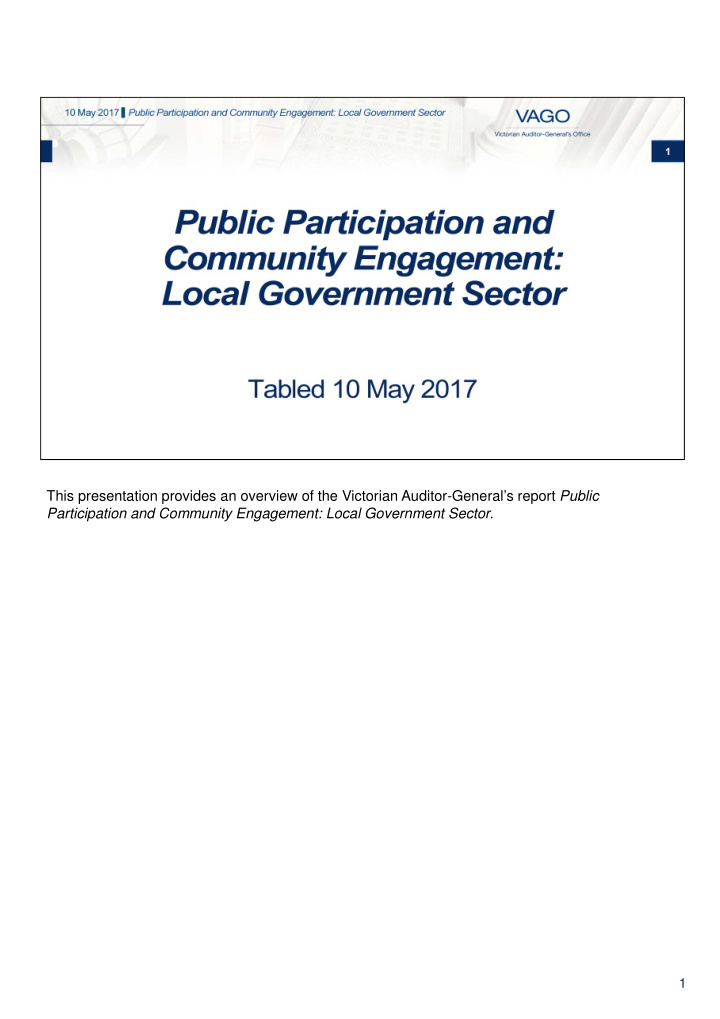



This presentation provides an overview of the Victorian Auditor-General’s report Public Participation and Community Engagement: Local Government Sector. 1
Public participation is the involvement of those affected by a decision in the decision-making process. Public participation encompasses a range of public involvement, from informing people about what government is doing to delegating decisions to the public. 2
Councils make decisions about a diverse range of community needs. To cater for these needs, effective public participation can help to better inform local government policies and their translation into effective strategies, programs and projects. 3
Victoria’s councils are supported by Local Government Victoria (LGV), which is part of the Department of Environment, Land, Water and Planning (DELWP). LGV works cooperatively with councils to ensure Victorians benefit from responsive and accountable local government. 4
In this audit, we examined the effectiveness of community engagement and participation at the local government level. We examined councils’ public participation processes for significant activities, such as developing the council budget and council plan, and making major investment decisions. We benchmarked these processes against better practice principles, in line with the International Association for Public Participation (IAP2) model of public participation. Alongside LGV, we selected six councils to audit. 5
Councils have a range of public participation policies, frameworks and guides for their staff, which set out expectations for public participation. We found that: • All six councils have a public participation policy or framework, and five were informed by the IAP2 principles. • Five councils also have public participation guides or handbooks, but their content and quality vary considerably. • We concluded that three of the six councils— Ballarat, Cardinia and Maribyrnong—should review their public participation policies and staff guides to include more better practice elements. To address these findings we recommended that all councils assess their public participation policies and resources against the IAP2 model, update them as necessary and promote their use amongst staff. 6
The audited councils mostly used quantitative measures to monitor and evaluate their public participation activities, and few projects were evaluated by analysing qualitative information. Five councils included the essential elements of monitoring, evaluation and review in their public participation policies. However, they did not have sufficient guidance on how to apply them. 7
All of the audited councils fulfilled their statutory obligations for public participation in their council budgets and council plans. We found that three councils had already made their decisions before conducting the public participation activities. However, we also found three councils that had engaged meaningfully with the community on the budget process. 8
We looked at a wide range of council community projects and activities where public participation was evident. We saw a two-way flow of information and the sharing of information within and between stakeholder communities during the decision-making process. We also found one example of empowering the community when the community was given the opportunity to consult on a funding allocation and decide how it would be spent. It is very positive to see that public participation for community projects was being conducted at the involve, collaborate and empower end of the spectrum. 9
LGV is responsible for promoting better practice in public participation to the local government sector, as well as reflecting better practice in a range of its own activities. LGV coordinates the statewide Local Government Community Satisfaction Survey. In 2015–16, four of the six audited councils scored lower than similar councils on community engagement. As you can see in the graph on this slide, scores ranged from 42 to 63 out of 100. Considering the relatively low scores, it would be beneficial for LGV to analyse the data and develop resources and initiatives that support councils to improve their practice. 10
We made three recommendations to councils to: • assess, update and promote their public participation policies • build monitoring, reporting and evaluation activities into public participation activities, and • develop and document comprehensive public participation plans and their outcomes. We also recommended that LGV analyse public participation data and promulgate better practice public participation case studies, guidance and training. All recommendations have been accepted and we will monitor their implementation progress. 11
For further information, please see the full report of this audit on our website, www.audit.vic.gov.au. 12
Recommend
More recommend